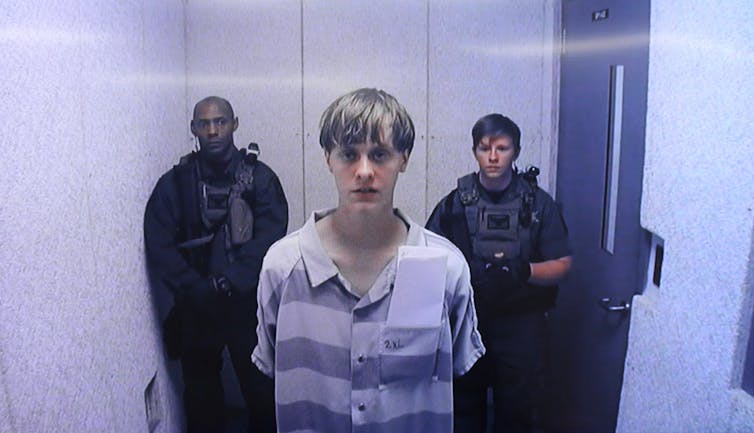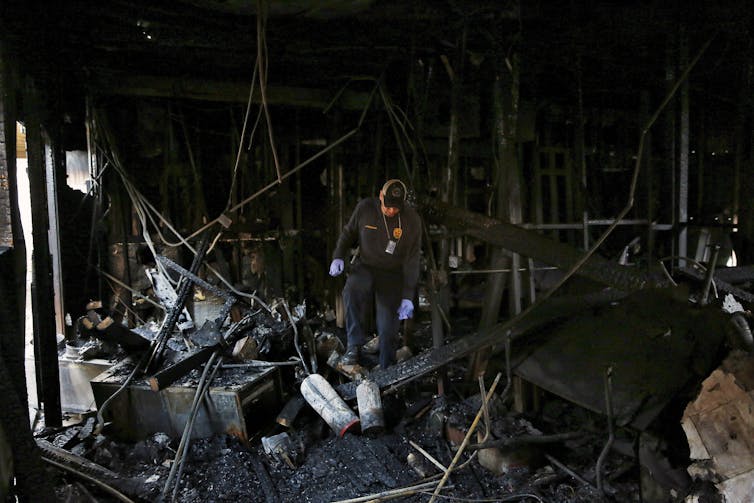What is a hate crime? The narrow legal definition makes it hard to charge and convict
- Written by Jeannine Bell, Professor of Law, Maurer School of Law, Indiana University
A white man travels to one business and kills several workers. He then kills more people at a similar business.
Six of the eight people he killed are Asian women, leading many people to call for him to be charged under the new state hate crime law[1]. Authorities resist, saying they aren’t sure that racial bias motivated the man’s crimes.
That’s the situation unfolding in the Atlanta area in Georgia, right now[2]. But there is often a gap between public opinion and law enforcement when people believe a hate crime has been committed, whether against LGBTQ people, racial minorities or Jewish people.
Hate crimes and hate murders are rising across the U.S., but long-term polling data suggests that most Americans are horrified by bias-motivated violence[3]. They also support hate crime legislation, an effort to deter such attacks.
Yet officials often resist the quick classification of incidents as a hate crime. Hate crimes have precise qualities, which must be met in order to satisfy legal requirements. And even when police and prosecutors believe the elements of a hate crime are present, such crimes can be difficult to prove in court.
What is a hate crime?
I have studied hate crime and police for over 20 years[4].
Hate crimes are crimes motivated by bias on the basis of race, religion, sexual orientation or ethnicity. In some states, gender, age and gender identity are also included. Hate crime laws have been passed by 47 states and the federal government since the 1980s, when activists first began to press state legislatures to recognize the role of bias in violence against minority groups[5]. Today, only Arkansas, South Carolina and Wyoming do not have hate crime laws.
In order to be charged as a hate crime, attacks – whether assault, killings or vandalism – must be directed at individuals because of the prohibited biases. Hate crimes, in other words, punish motive; the prosecutor must convince the judge or jury that the victim was targeted because of their race, religion, sexual orientation or other protected characteristic.
If the defendant is found to have acted with bias motivation, hate crimes often add an additional penalty to the underlying charge. Charging people with a hate crime, then, presents additional layers of complexity[6] to what may otherwise be a straightforward case for prosecutors. Bias motivation can be hard to prove, and prosecutors can be reluctant to take cases that that they may not win[7] in court.
It can and does happen, though. In June 2020, Shepard Hoehn placed a burning cross and a sign with racial slurs and epithets facing the construction site where his new neighbor, who is Black, was building a house.
Hoehn was charged with and later pleaded guilty to federal hate crime charges[8] in Indiana. A few months later, Maurice Diggins was convicted by a federal jury of a 2018 hate crime for breaking the jaw of a Sudanese man in Maine while shouting racial epithets[9].
 Dylann Roof, who killed nine worshipers at a Black church in South Carolina in 2015, was convicted of 33 charges, including hate crimes.
Grace Beahm-Pool/Getty Images[10]
Dylann Roof, who killed nine worshipers at a Black church in South Carolina in 2015, was convicted of 33 charges, including hate crimes.
Grace Beahm-Pool/Getty Images[10]
How to charge a hate crime
The first use of the term “hate crime” in federal legislation was the Hate Crimes Statistics Act of 1990[11]. This was not a criminal statute but rather a data-gathering requirement that mandated that the U.S. attorney general collect data on crimes that “evidenced prejudice based on race, religion, sexual orientation, or ethnicity.”
Soon, states began passing their own laws recognizing bias crimes. But hate crime legislation has not led to as many charges and convictions as activists may have hoped.
Law enforcement struggle to identify hate crime and prosecute the offenders. Even though 47 states have hate crime laws, 86.1% of law enforcement agencies reported to the FBI that not a single hate crime had occurred in their jurisdiction in 2019[12], according to the latest FBI data collected.
In many cases, police have received inadequate training[13] in making hate crime classification.
“What weights do you give to race, dope, territory? These things are 90% gray – there are no black-and-white incidents,” said one 20-year veteran police officer in a 1996 study of hate crime[14].
But I’ve also found that police departments are rarely organized in a way that allows them to develop the expertise necessary to effectively investigate hate crimes[15]. When police departments have specialized police units and prosecutors who are committed to taking on hate crime[16], they can develop the routines that allow them to investigate hate crime in a manner that supports victims.
In the late 1990s I studied a specialized police hate crime unit in a city I called, for the purposes of anonymity, “Center City.” My study revealed that those detectives could distinguish non-hate crimes – for instance, when the perpetrator angrily used the n-word in a fight – from cases that are truly hate crimes, as when the perpetrator used it during a targeted attack on a Black person.
Without the right training and organizational structure, officers are unclear about common markers of bias motivation, and tend to assume that they must go to extraordinary lengths to figure out why suspects committed the crime.
“We don’t have time to psychoanalyze people,” said the same veteran police officer in 1996.
Even law enforcement officers specifically trained in bias crime identification still may not name incidents as hate crime that, to the general public, seem obviously bias-driven[17]. This may be the result of police bias.
 When arson targets a temple, mosque or cultural center, it may be investigated as a hate crime.
Aaron M. Sprecher/AFP via Getty Images[18]
When arson targets a temple, mosque or cultural center, it may be investigated as a hate crime.
Aaron M. Sprecher/AFP via Getty Images[18]
Limits of the law
Advocates for hate crime victims maintain that police and prosecutors can do much more[19] to identify and punish hate crimes.
Empirical evidence supports their claims. The FBI’s 2019 report contains 8,559 bias crimes reported by law enforcement agencies[20]. But in the National Crime Victimization Survey, victims say that they experienced, on average, more than 200,000 hate crimes each year[21]. This suggests that police are missing many hate crimes that have occurred.
Distrust of police[22], especially in Black communities, may dissuade minorities from even calling the police when they are victimized by hate crime for fear they could also become victims of police violence[23].
All this means that perpetrators of hate crimes may not be caught and can reoffend, further victimizing communities that are meant to be protected by hate crime laws.
Hate crime laws reflect American ideals of fairness, justice and equity. But if crimes motivated by bias aren’t reported, well investigated, charged or brought to trial, the law matters littl
References
- ^ new state hate crime law (www.washingtonpost.com)
- ^ unfolding in the Atlanta area in Georgia, right now (www.nytimes.com)
- ^ horrified by bias-motivated violence (news.gallup.com)
- ^ hate crime and police for over 20 years (scholar.google.com)
- ^ press state legislatures to recognize the role of bias in violence against minority groups (www.jstor.org)
- ^ presents additional layers of complexity (jhs.press.gonzaga.edu)
- ^ take cases that that they may not win (doi.org)
- ^ federal hate crime charges (www.justice.gov)
- ^ while shouting racial epithets (www.justice.gov)
- ^ Grace Beahm-Pool/Getty Images (www.gettyimages.com)
- ^ Hate Crimes Statistics Act of 1990 (www.govtrack.us)
- ^ had occurred in their jurisdiction in 2019 (ucr.fbi.gov)
- ^ inadequate training (www.propublica.org)
- ^ one 20-year veteran police officer in a 1996 study of hate crime (www.jstor.org)
- ^ expertise necessary to effectively investigate hate crimes (doi.org)
- ^ committed to taking on hate crime (nyupress.org)
- ^ to the general public, seem obviously bias-driven (www.propublica.org)
- ^ Aaron M. Sprecher/AFP via Getty Images (www.gettyimages.com)
- ^ police and prosecutors can do much more (www.propublica.org)
- ^ 8,559 bias crimes reported by law enforcement agencies (ucr.fbi.gov)
- ^ more than 200,000 hate crimes each year (www.bjs.gov)
- ^ Distrust of police (theconversation.com)
- ^ victims of police violence (theconversation.com)
Authors: Jeannine Bell, Professor of Law, Maurer School of Law, Indiana University

